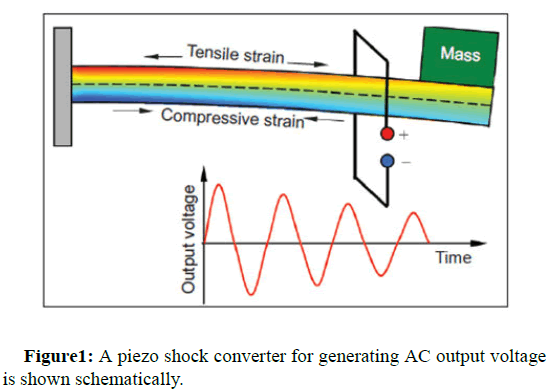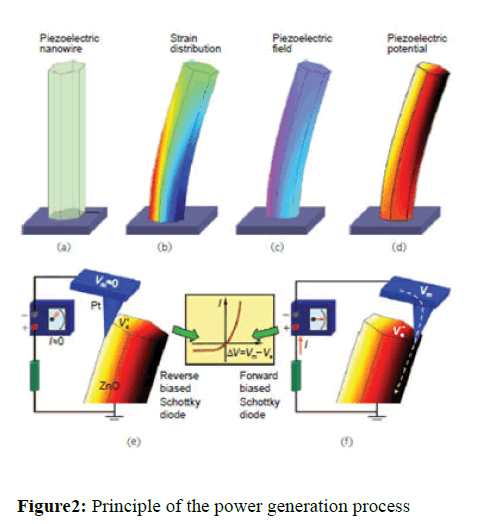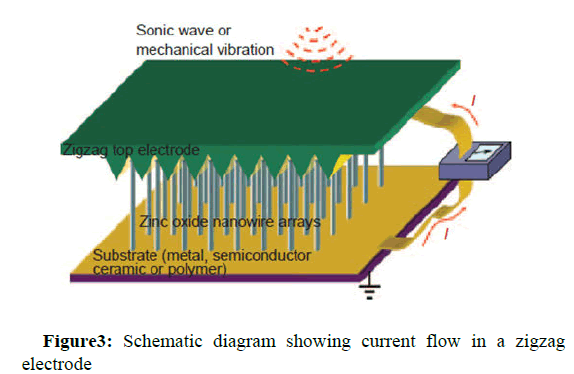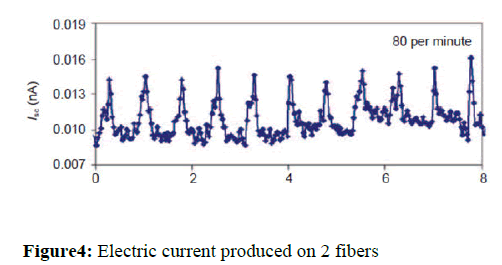Research Article, J Nucl Ene Sci Power Generat Technol Vol: 10 Issue: 2
Sustainable Energy Harvesting for Self-Powered Micro/Nanosystems Enabled by Nanotechnology
Chandrika V S1*, T. S. Karthik2, J Bhaskaran3, Kantilal P. Rane4, M K Loganathan5
1Department of Electrical and Electronics Engineering, KPR Institute of Engineering and Technology, Coimbatore, India
2Department of Electronics and Communication Engineering, Aditya College of Engineering and Technology, Surampalem. India
3Department of Mechanical Engineering, Adama Science and Technology University, Ethiopia
4Department of Electronics and Telecommunication, KCEs College of Engineering and Management, Jalgaon, MS, India
5Department of Mechanical Engineering, The Assam Kaziranga University, Jorhat, Assam, India
- *Corresponding Author:
- Chandrika V S
Department of Electrical and Electronics Engineering,
Engineering KPR Institute of and Technology,
Coimbatore,
India,
E-mail: mailchandrika@gmail.com
Received date: August 31, 2021; Accepted date: November 22, 2021; Published date: December 03, 2021
Citation: Chandrika V S, Karthik TS, Bhaskaran J, Rane KP, Loganathan MK (2021) Sustainable Energy Harvesting for Self-Powered Micro/Nanosystems Enabled by Nanotechnology. J Nucl Ene Sci Power Generat Technol 10:11
Abstract
The section provides an overview of energy collecting techniques that have the ability to energize nanosystems. The focus of our discussion is on methods apart from the well- known solar panel and thermoelectrics. The piezo nanomaterials made using aligned ZnO nanowire arrays are the focus of this paper. This is a base improving in manufacturing sector for transforming movement energy, vibration energy, and hydraulic energy into power for self- energized nanostructures.
Keywords: Nanomaterials; Self-energized system; Energy storage
Introduction
Discovering sustainable, ecological, and clean sources of energy is the most pressing problem facing human humankind's long-term growth [1,2]. Injectable biosensors, ultrasonic biochemical and computational modeling sensors, nanorobotics, remote or mobile monitoring devices, homeland security, or even personal computers gadgets all produce power and technology to operate independently and continuously. A nanorobot, for instance, is envisioned as a micro controller that can detect and adjust to its surroundings, handle things, make decisions, and execute complicated duties. However, finding a source of power that can run the nanorobot while introducing much mass is a major issue.
A power supply is required for an implanted wireless biosensor, which can be given actively or passively via recharging the battery. It is extremely desirable for connected technologies to be self-powered but without batteries, and it is even necessary for implantable medical technology. As a result, developing nanotechnology that gathers information from the environment for self-powering such nanomaterials is critical. This is an important step on the path to selfpowered nanosystems [3-6]. If only a tiny portion of this energy could be turned into energy, it could be enough to run modest biomedical equipment [7].
Microbes can be utilised to convert electrical bioconvertible substrate into energy, with the bacterium acting as an electrode and electron flowing from the discharge via a resistance [8]. Direct glucose battery packs have been demonstrated to last 150 days in animal testing. All eukaryotic creatures, like humans, have oxygen and glucose in their cells and tissues. As a result, it is feasible to utilise a single SnO2 nanobelt to detect dimethyl methylphosphonate (DMMP), a nerve agent stimulator, at a concentration of 50 ppb [9].
Using fuel consumption, vibrations, and piezo (PZ) pulsation, researchers have devised different techniques for recycling power for mobile wireless nanoelectronics [10]. Photovoltaic (PV) is a wellknown energy scavenging technique that uses a photon- electron excitation mechanism in organic semiconductors to transform sunlight into electricity. Our cells have the ability to create sufficient electricity to produce a variety of therapeutic devices, such as medication delivery systems, diagnostic instruments, and human enhancement technologies, in the human body [11].
Enzymes have been considered as a potential source of energy for future macroscopic systems [12]. The engines are powered by the ATP, which would be made up of covalently bonded adenine, ribose, and three phosphate groups. When the initial phosphate person exhales, a substantial quantity of energy is accompanied by the release of adenosine diphosphate, which is indicated by a coenzyme (ADP). If more force is generated, the additional phosphate is released, resulting in adenosine monophosphate (AMP) [13]. The energy generated is needed for photosynthesis, movement and dynamic ion and chemical transportation through cellular membrane. The chemical energy created by the oxidation of food is used to rephosphorylate ADP and AMP, which refuels ATP. As a result of this notion, ATP may be used as a battery charger within the human body.
The difference in energy between the two ends determines the voltage produced. The Dielectric constant often called the thermal energy or thermopower, is the constant of proportionality. This is the mechanical foundation for a thermometer, which is commonly used to monitor temperature. The amplitude of a generated thermoelectric voltage caused by temperature differential across a material is defined by its Seebeck coefficient. Charge particles throughout the substance, whether electron or holes, leak from the hot to the cold end whenever a temperature differential is introduced, similar to how a classic gas expands when warmed. Moving mobile leading provider to the cold side leave the opposite charges and stationary nucleus on the warm side, resulting in a thermodynamic voltage.
Among the most intriguing topics in nanotechnology is thermoelectrics [14]. One-dimensional nanoparticles like Bi and BiTe, which have a high thermal conductivity but a high electrical conductivity, are particularly useful for increasing thermal energy. And the need to maintain a greater temperature differential between both the opposite edges of the gadget, electrical devices are typically huge.
Researchers have used three types of mechanical sensors to create vibration-based power stations: magnetic, electromagnetic, and piezo. In a tight circuit, a magnetic microgenerator uses a rotating magnetic or coils to embed and oscillating electric charge. The innovation produces large buildings ranging from 1 75 cm3, going to explore vibratory distances from 50 Hz to 5 kHz which stimulate pneumatic fluctuations among one micrometre or over one millimetre, and producing energy ranging from thousands of W from over one kW.
The double piezo beams with a weight just at terminus is used in a conventional piezo shock converter (Fig. 1). When gravitational acceleration the beams below, the upper piezo layer suffers stress distribution, whereas the lowest part suffers stress concentration, leading in positive and negative power throughout the beam, respectively. As the load rotates backwards and forwards, a voltage difference is generated. This approach was the original concept for converting acoustic energy into electrical energy for microprocessors. Gravitation has a big part in causing the oscillation of the mass since this energy generator is quite enormous. This type has long had one of the most significant microgenerators in portable wireless technologies.
Piezoelectric Nanogenerators
As illustrated in Fig. 1, gravity has practically little role in the mass motion when the beam size is in the nanoscale scale, therefore the suggested generator would not function. Nanoscale energy sources require innovation in order for nanodevices and nanosystems to function autonomously. We've looked at new nanomaterials for transforming mechanical power (like muscle stretching), vibration energy (like acoustic/ electromagnetic wave), and hydraulic energy (like bodily monitoring of blood flow) into electric energy which can be utilised to operate nanosystems even without usage of batteries [15].
The basic process for producing, isolating, and sustaining piezo charge in the NW is a link of piezo and super materials properties [16]. A stress voltage is created when an AFM tip bends a horizontal, flat ZnO NW, with the outside tension as well as the internal surface compression (Fig. 2(b)). Inside the NW volume, the piezoelectric action generates a piezoelectric field Ez along the NW, with both the piezoelectric field parallel to the NW at the outermost layer and to the NW only at the internal surfaces (Fig. 2(c)).
We'll next looking at how to calculate the voltage output. During the first step, the AFM sensitivity tip induces distortion by coming into contact with both the term of trade of electrostatic (Figs. 2(d) and (e)). In the this instance, the Pt metal ZnO semiconductor (M-S) contact is a reverse-biased Schottky diodes (Fig. 3(e)), and negligible current flows across the contained multiplicity to both the ZnO NWs n-type semiconductor features. That one is the act of producing, distributing, and receiving energy. As in second step, whenever the AFM tips are in touch with both the compressed surface of a NW (Fig. 2(f)), the metal tip ZnO connection is negatively biassed for V=Vm V s > 0. The M S connection in this instance is positively biassed Schottky diodes, resulting in a rapid increase in the outgoing electrical current[17].
Direct-current by ultrasonic wave
To begin, we should remove the usage of AFM for martensitic transformation of the NWs, allowing for a more flexible, transportable, and cost-effective method to power production on a wider scale. Second, every one of the NWs must create power at the same time and in the same amount, the power to be regained to electrical energy must come from the surroundings in the context of a pulse or vibrations, allowing the piezoelectric material to function "autonomously" and remotely. We've devised a novel strategy to solve these issues [18].
Zigzag Si electrodes covered with Pt covers a multitude of matched ZnO NWs inside the equipment shown in Figure 3. The Pt covering increases the conductivity of the electrodes while simultaneously forming a Schottky contact at the ZnO contact. The upper device is connected up of similar zigzag trenches on a (001) orientated Si chip with such a thick Pt covering over topping.
Energy Producer by Polymer Substrate
The instrumentation is generally depicted in Fig. 3, where a zigzag Si electrode coated with Pt covers an array of aligned ZnO NWs. The Pt covering not only increases the electrode's conductance.
Fiber-Based Power Shirt
We have to build nanogenerators that are based on elastic and bendable substrate and targeting lower frequencies vibrations (usually 10 Hz) to collect the power accessible from biological systems [21]. The zigzag electrodes have substituted with a grid of copper wire, as illustrated in Figure 4
The twist of the Nanowires creates output current during a cyclic comparative slide between both the two strands (Fig. 4). The fiberbased nanogenerator [22 -31] can harvest energy via body movement, muscular stretch, gentle breeze, and vibrations.
Conclusion
In general, this study discusses the many techniques for collecting information from the environment for reduced purposes which have been demonstrated. The piezoelectric motion generator is arguably the most successful technique for nanowires and nanotechnologies. A innovative nanogenerator has also been proved and it has the ability to encourage mechanical motion power (like physical movement, muscular straining, heart rate), vibration energy (like elastic waves), and hydraulic energy (like flow of bodily fluids, blood circulation, artery shrinkage, flexible liquid in natural world) into electrical power that may be used in various applications. By harvesting information from the environment, the technique might have major implications in wireless self-powered nanotechnology. It also includes a way for charging batteries indirect.
References
- Special issue on Sustainability and Energy, Sci 2007
- Special issue on Harnessing Materials for Energy, MUS Bull. 2008, 33 (4)
- Wang, Z. L. Self-powering nanotech. Scientific American 2008, 82 87.
- Yu C, Hao Q, Saha S, Shi L, Kong X, et al. (2005) Integration of metal oxide nanobelts with microsystems for nerve agent detection. Appl Phys Lett 86, 063101.
- Paradiso JA (2005) Starner, T. Energy scavenging for mobile and wireless electronics. IEEE Pervasive Computing 14, 18 27
- Leland ES, Baker J, Carleton E, Reilly E, Lai E, et al. (2005) IEEE Pervasive Computin 14, 18 28.
- Tian, B, Xiaolin, Z, Kempa, TJ, Fang, Y, Yu N, et al. (2007) Coaxial silicon nanowires as solar cells and nanoelectronic power sources. Nature 449, 885 890.
- Bond, DR, Holmes, DE, Tender, LM, Lovley, DR (2002) Electrode-reducing microorganisms that harvest energy from marine sediments. Sci 295, 483 485.
- Bond, DR, Holmes, DE, Tender, LM, Lovley, DR (2002) Electrode-reducing microorganisms that harvest energy from marine sediments. Sci 295, 483 485.
- Bachand, GD, Montemagno, CD (2002) Constructing organic/ inorganic NEMS devices powered by biomolecular motors. Biomed. Microdevices 2, 179 185.
- Kitamura, H, Tokunaga, M, Iwane, AH, Yanagida, T. (1999) A single myosin head moves along an actin filament with regular steps of 5.3 nanometres. Nature 397, 129 134.
- Wang, MD, Schnitzer, MJ, Yin, H, Landick, R, Gelles, J, et al. (1998) Force and velocity measured for single molecules of RNA polymerase. Sci 282, 902 907.
- Noji, H, Yasuda, R, Yoshida, M, Kinosita, KJr (1997) Direct observation of the rotation of F1-ATPase, 386, 299 302.
- Shi, L, Li, D, Yu, C, Jang, W, Kim, D, et al (2003) Measuring thermal and thermoelectric properties of one-dimensional nanostructures using microfabricated device. J. Heat Transfer, 125, 881 888.
- Yasuda, R, Noji, H, Kinosita, KJr, Yosida, M (1998) F1- ATPase is a highly efficient molecular motor that rotates with discrete 120˚ steps. 93, 1117 1124.
- Wang, ZL, Song, JH, (2006) Piezoelectric nanogenerators based on zinc oxide nanowire arrays. Sci 312, 242 246.
- Song, JH, Zhou, J, Wang, Z (2006) Piezoelectric and semiconducting coupled power generating process of a single ZnO belt/wire. A technology for harvesting electricity from the environment. Nano Lett. 6, 1656 1662.
- Zhou, J, Xu, NS, Wang, ZL (2006) Dissolving behavior and stability of ZnO wires in biofluids: A study on biodegradability and biocompatibility of ZnO nanostructures. Adv. Mater 18, 2432 2435.
- Wang, XD, Song, JH, Liu, J, Wang, ZL (2007) Direct- current nanogenerator driven by ultrasonic waves. Science 316, 102 105.
- Liu, J, Fei, P, Zhou, J, Tummala, R, Wang, ZL (2008) Toward high output-power nanogenerator. Appl. Phys. Lett. in press.
- Qin, Y, Wang, XD, Wang, ZL (2008) Microfiber-nanowire hybrid structure for energy scavenging. Nature 451, 809 813.
- Gao, PX, Song, JH, Liu, J, Wang, ZL (2007) Nanowire nanogenerators on plastic substrates as a flexible power source. Adv. Mater 19, 67 72.
- Qin, Y, Wang, XD, Wang, ZL (2008) Microfiber-nanowire hybrid structure for energy scavenging. Nature 451, 809 813.
- Sneha P, Balamurugan K, Kalusuraman G (2020) Effects of Fused Deposition Model parameters on PLA-Bz composite filament. InIOP Conference Series: Mat Sci and Eng 988 (1): 012028 IOP Publishing.
- Devaraj S, Malkapuram R, Singaravel B (2021) Performance analysis of micro textured cutting insert design parameters on machining of Al-MMC in turning process. Int j.lightweight mater. manuf 4 (2): 210-7
- Rama Krishna M, Tej Kumar KR, DurgaSukumar G (2018) Antireflection nanocomposite coating on PV panel to improve power at maximum power point. Energy Sources, Part A: Recovery, Utilization, and Environmental Effects 40 (20): 2407-14.
- Yarlagaddaa J, Malkapuram R, Balamurugan K (2021) Machining Studies on Various Ply Orientations of Glass Fiber Composite. InAdvances in Industrial Automation and Smart Manufacturing pp. 753-769 Springer, Singapore.
- Sekaran, K, Rajakumar, R, Dinesh, K, Rajkumar, Y, Latchoumi, TP, et al (2020). An energy-efficient cluster head selection in wireless sensor network using grey wolf optimization algorithm. TELKOMNIKA, 18(6): 2822-2833.
- Garigipati RK, Malkapuram R (2020) Characterization of novel composites from polybenzoxazine and granite powder. SN Appl Sci. 2 (9): 1-9.
- Yarlagaddaa J, Malkapuram R (2020) Influence of carbon nanotubes/graphene nanoparticles on the mechanical and morphological properties of glass woven fabric epoxy composites. INCAS Bulletin 12 (4): 209-18.
- Ranjeeth, S, & Latchoumi, TP (2020) Predicting Kids Malnutrition Using Multilayer Perceptron with Stochastic Gradient Descent. Rev. d'Intelligence Artif 34(5): 631-636.
 Spanish
Spanish  Chinese
Chinese  Russian
Russian  German
German  French
French  Japanese
Japanese  Portuguese
Portuguese  Hindi
Hindi 





